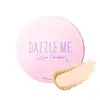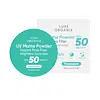Dazzle Me Always Setting Loose Powder Versus Luxe Organix 24h Zero Sebum Instant Pore Blurring Matte Powder SPF 50
What's inside
What's inside
 Key Ingredients
Key Ingredients

 Benefits
Benefits

 Concerns
Concerns

 Ingredients Side-by-side
Ingredients Side-by-side

Corn Starch Modified
AbsorbentSilica
AbrasiveSynthetic Fluorphlogopite
Mica
Cosmetic ColorantPhenoxyethanol
PreservativeMagnesium Myristate
Dimethicone
EmollientTocopheryl Acetate
AntioxidantTriethoxycaprylylsilane
Titanium Dioxide
Cosmetic ColorantPhenyl Trimethicone
Skin ConditioningParfum
MaskingAluminum Hydroxide
EmollientEthylhexylglycerin
Skin ConditioningCyclopentasiloxane
EmollientPolymethylsilsesquioxane
Hydrated Silica
AbrasiveHydrogen Dimethicone
Ascorbic Acid
AntioxidantArbutin
AntioxidantEthylhexyl Palmitate
EmollientSaccharomyces/Rice Ferment Filtrate
Skin ConditioningWater
Skin ConditioningHydrogenated Polyisobutene
EmollientGlycerin
HumectantHydrogenated Lecithin
EmulsifyingCalendula Officinalis Flower Extract
MaskingCeramide NP
Skin ConditioningCaprylyl Glycol
EmollientPropylene Glycol
HumectantChrysanthellum Indicum Extract
Skin ConditioningButylene Glycol
HumectantTrihydroxystearin
Skin Conditioning1,2-Hexanediol
Skin ConditioningSodium Hyaluronate
HumectantGlucomannan
Skin ConditioningCI 77891
Cosmetic ColorantCI 77492
Cosmetic ColorantCI 77491
Cosmetic ColorantCorn Starch Modified, Silica, Synthetic Fluorphlogopite, Mica, Phenoxyethanol, Magnesium Myristate, Dimethicone, Tocopheryl Acetate, Triethoxycaprylylsilane, Titanium Dioxide, Phenyl Trimethicone, Parfum, Aluminum Hydroxide, Ethylhexylglycerin, Cyclopentasiloxane, Polymethylsilsesquioxane, Hydrated Silica, Hydrogen Dimethicone, Ascorbic Acid, Arbutin, Ethylhexyl Palmitate, Saccharomyces/Rice Ferment Filtrate, Water, Hydrogenated Polyisobutene, Glycerin, Hydrogenated Lecithin, Calendula Officinalis Flower Extract, Ceramide NP, Caprylyl Glycol, Propylene Glycol, Chrysanthellum Indicum Extract, Butylene Glycol, Trihydroxystearin, 1,2-Hexanediol, Sodium Hyaluronate, Glucomannan, CI 77891, CI 77492, CI 77491
Mica
Cosmetic ColorantAluminum Starch Octenylsuccinate
AbsorbentTalc
AbrasiveZinc Oxide
Cosmetic ColorantTitanium Dioxide
Cosmetic ColorantSilica
AbrasiveCaprylic/Capric Triglyceride
MaskingDimethicone
EmollientAluminum Hydroxide
EmollientOctyldodecyl Stearoyl Stearate
EmollientStearic Acid
CleansingMagnesium Myristate
Triethoxycaprylylsilane
Acetyl Glucosamine
Skin ConditioningBis-Diglyceryl Polyacyladipate-2
EmollientSynthetic Fluorphlogopite
Resveratrol
AntioxidantAscorbic Acid
AntioxidantEthylhexylglycerin
Skin ConditioningTocopheryl Acetate
AntioxidantIron Oxides
Mica, Aluminum Starch Octenylsuccinate, Talc, Zinc Oxide, Titanium Dioxide, Silica, Caprylic/Capric Triglyceride, Dimethicone, Aluminum Hydroxide, Octyldodecyl Stearoyl Stearate, Stearic Acid, Magnesium Myristate, Triethoxycaprylylsilane, Acetyl Glucosamine, Bis-Diglyceryl Polyacyladipate-2, Synthetic Fluorphlogopite, Resveratrol, Ascorbic Acid, Ethylhexylglycerin, Tocopheryl Acetate, Iron Oxides
Ingredients Explained
These ingredients are found in both products.
Ingredients higher up in an ingredient list are typically present in a larger amount.
Aluminum Hydroxide is a form of aluminum. It can be naturally found in nature as the mineral gibbsite. In cosmetics, Aluminum Hydroxide is used as a colorant, pH adjuster, and absorbent.
As a colorant, Aluminum Hydroxide may add opacity, or reduce the transparency. Aluminum hydroxide is contains both basic and acidic properties.
According to manufacturers, this ingredient is an emollient and humectant. This means it helps hydrate the skin.
In medicine, this ingredient is used to help relieve heartburn and help heal ulcers.
There is currently no credible scientific evidence linking aluminum hydroxide in cosmetics to increased cancer risk.
Major health organizations allow the use of aluminum hydroxide in personal care products and have not flagged it as a carcinogenic risk at typical usage levels.
Learn more about Aluminum HydroxideAscorbic Acid is is pure Vitamin C. This form makes up the largest amount of vitamin C found naturally in our skin.
Not only is vitamin C great for your overall health and immune system, it also has plenty of benefits on your skin.
Vitamin C is best used for brightening skin. It improves dark spots, acne scars, and hyperpigmentation. This is because it blocks the process of skin darkening when exposed to UV.
Remember: Vitamin C should not replace sunscreen!
Your skin uses vitamin C to build collagen. Collagen is one key component in having a strong skin barrier and plump skin. Vitamin C also plays a role in regulating collagen, thus making it effective in improving wrinkles and fine lines.
Ascorbic acid shows potent antioxidant activity. As an antioxidant, it helps fight free-radicals. Free-radicals are molecules that may damage your skin cells. These antioxidants also protect skin against UV damage.
The best formulations include Vitamin E and/or ferulic acid. These two ingredients help stabilize and provide a boost in the benefits of ascorbic acid. This is because ascorbic acid becomes unstable when exposed to UV and air. In fact, you can tell your ascorbic acid has oxidized when it turns an orange-yellow color.
Ascorbic acid is generally compatible with other ingredients. However, using ascorbic acid with other active ingredients might cause irritation. Two ingredients: copper ions and benzoyl peroxide, will inactivate ascorbic acid completely.
Read more about other types of Vitamin C:
Foods rich with vitamin C include oranges, strawberries, broccoli, bell peppers, and more. When consuming Vitamin C, your skin receives a portion of the nutrients.
Learn more about Ascorbic AcidDimethicone is a type of synthetic silicone created from natural materials such as quartz.
What it does:
Dimethicone comes in different viscosities:
Depending on the viscosity, dimethicone has different properties.
Ingredients lists don't always show which type is used, so we recommend reaching out to the brand if you have questions about the viscosity.
This ingredient is unlikely to cause irritation because it does not get absorbed into skin. However, people with silicone allergies should be careful about using this ingredient.
Note: Dimethicone may contribute to pilling. This is because it is not oil or water soluble, so pilling may occur when layered with products. When mixed with heavy oils in a formula, the outcome is also quite greasy.
Learn more about DimethiconeEthylhexylglycerin (we can't pronounce this either) is commonly used as a preservative and skin softener. It is derived from glyceryl.
You might see Ethylhexylglycerin often paired with other preservatives such as phenoxyethanol. Ethylhexylglycerin has been found to increase the effectiveness of these other preservatives.
We don't have a description for Magnesium Myristate yet.
Mica is a naturally occurring mineral used to add shimmer and color in cosmetics. It can also help improve the texture of a product or give it an opaque, white/silver color.
Serecite is the name for very fine but ragged grains of mica.
This ingredient is often coated with metal oxides like titanium dioxide. Trace amounts of heavy metals may be found in mica, but these metals are not harmful in our personal products.
Mica has been used since prehistoric times throughout the world. Ancient Egyptian, Indian, Greek, Roman, Aztec, and Chinese civilizations have used mica.
Learn more about MicaSilica, also known as silicon dioxide, is a naturally occurring mineral. It is used as a fine, spherical, and porous powder in cosmetics.
Though it has exfoliant properties, the function of silica varies depending on the product.
The unique structure of silica enhances the spreadability and adds smoothness, making it a great texture enhancer.
It is also used as an active carrier, emulsifier, and mattifier due to its ability to absorb excess oil.
In some products, tiny microneedles called spicules are made from silica or hydrolyzed sponge. When you rub them in, they lightly polish away dead skin layers and enhance the penetration of active ingredients.
Learn more about SilicaSynthetic Fluorphlogopite is the synthethic version of mica. It consists of fluorine, aluminum and silicate.
Synthetic Fluorphlogopite is used to add volume to products.
It is considered non-irritating on the skin.
Learn more about Synthetic FluorphlogopiteTitanium dioxide is a mineral UV filter widely used in sunscreens and cosmetics.
It is one of only two UV filters officially classified as “mineral” by regulatory agencies, the other being zinc oxide.
Titanium dioxide provides broad-spectrum protection mostly in the UVB and UVAII range, with some protection in the UVAI range.
While its UVA protection isn’t as strong as zinc oxide’s, the difference is minor.
A common myth is that mineral UV filters reflect UV light. However, modern research shows titanium dioxide absorbs UV radiation like chemical filters (~95% absorption & 5% reflection).
Thanks to its non-irritating nature, titanium dioxide is suitable for sensitive, acne-prone, or redness-prone skin. It is unlikely to cause "eye sting" like other sunscreen ingredients.
A major drawback of this ingredient is its white cast and thick texture. This is why mineral sunscreens often leave a white cast and are less cosmetically elegant than chemical/hybrid sunscreens.
To improve white cast and spreadability, micronized or nano-sized titanium dioxide is often used.
There are ongoing concerns surrounding nano-titanium oxide's impact on marine ecosystems.
There is no conclusive evidence that any form of titanium oxide (or any other sunscreen ingredients) will cause harm to marine ecosystems or coral reefs. The science is still developing but many consumers are keeping a close eye on this issue.
Please note, many destinations have reef-safety sunscreen rules. For instance, the U.S. Virgin Islands advises all visitors to use non-nano mineral sunscreens.
Nano mineral sunscreens once raised safety concerns about absorption into skin.
Extensive research has shown that they do not penetrate healthy or damaged skin; they remain safely on the surface and the top layer of dead skin (stratum corneum).
You'll likely find titanium dioxide bundled with alumina, silica, or dimethicone. These ingredients help make titanium dioxide highly photostable; this prevents it from interacting with other formula components under UV light.
Learn more about Titanium DioxideTocopheryl Acetate is AKA Vitamin E. It is an antioxidant and protects your skin from free radicals. Free radicals damage the skin by breaking down collagen.
One study found using Tocopheryl Acetate with Vitamin C decreased the number of sunburned cells.
Tocopheryl Acetate is commonly found in both skincare and dietary supplements.
Learn more about Tocopheryl AcetateTriethoxycaprylylsilane is a silicone used to bind and stabilize ingredients.
As an emulsifier, it helps prevent ingredients from separating. This can help elongate the shelf life of products.
Triethoxycaprylylsilane is often used to coat mineral sunscreens ingredients to help give a better feel. It also helps reduce oxidative stress in sunscreens.
Learn more about Triethoxycaprylylsilane